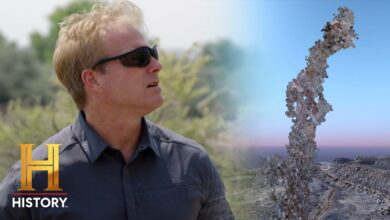Inside Skinwalker Ranch: Brandon Fugal’s Scientific Quest into America’s Greatest Paranormal Mystery
Inside Skinwalker Ranch: Brandon Fugal’s Scientific Quest into America’s Greatest Paranormal Mystery

Fugal and his vision
In the rolling hills of eastern Utah’s Uinta Basin, where ancient geological forces have sculpted a landscape both beautiful and mysterious, Brandon Fugal made a decision that would change his life forever.
It was 2016, and the successful real estate mogul — already recognized as an EY Entrepreneur of the Year and chairman of Colliers International’s Utah operations — was about to become the custodian of America’s most enigmatic property.
Fugal’s background wasn’t in the paranormal. With over two decades building one of the nation’s most successful commercial real estate empires, having closed transactions worth billions and earned recognition as the first global agent for Coldwell Banker Commercial, he was a man of facts, figures, and hard business realities.
Yet something about the 512-acre ranch in the basin called to him — not as a believer in the supernatural, but as someone who understood the value of systematic investigation.
“This isn’t about chasing ghosts,” Fugal would later explain to his team. “This is about applying the same rigorous standards we use in business to understand phenomena that frankly we don’t yet have adequate explanations for.”
Assembling the Team
When Fugal decided to launch what he called “the most aggressive research effort ever undertaken at the ranch,” he knew he needed credible scientists — not paranormal investigators or ghost hunters, but legitimate researchers with impeccable credentials who could withstand academic scrutiny.
Dr. Travis Taylor was the perfect choice. With multiple advanced degrees from Auburn University and the University of Alabama in Huntsville, over 16 years of experience with NASA and Department of Defense programs, and service as Chief Scientist for the Pentagon’s Unidentified Aerial Phenomena Task Force, Taylor brought unassailable scientific credibility to the endeavor.
His patents in advanced sensor technologies and optical systems demonstrated his expertise in the very instruments they would need.
“What attracted me to this project,” Taylor reflected during one of his extensive interviews, “wasn’t any belief in the paranormal. It was the opportunity to apply hard science to unexplained phenomena in a controlled environment. If something unusual is happening here, we’re going to measure it, document it, and understand it.”
Building a World-Class Laboratory
Rather than approach the ranch with amateur ghost-hunting equipment, Fugal invested millions in creating what would become one of the most sophisticated monitoring facilities in the world.
Partnering with technology giants Samsung and VernetX, the team constructed a state-of-the-art command center that would make NASA envious.
The facility featured Samsung interactive displays throughout, allowing researchers to visualize and analyze terabytes of data in real time. Samsung tablets enabled field teams to collect and transmit data instantly back to the command center, while VernetX’s military-grade war room software provided encrypted communications.
Advanced AI analytics platforms from partners like Omnitech processed the constant stream of information from dozens of sensors positioned across the property.
“For the first time in history,” explained Darl McBride, Chief Operating Officer at VernetX, “we have the ability to create a realistic picture of phenomena across an entire environment of this scale. The technology allows researchers to interact with data and identify patterns that would be impossible to detect otherwise.”
The Water Mystery: A Geological Detective Story
One of the team’s most intriguing investigations began with a simple question: Where does water go when it disappears into the ranch’s mysterious sinkholes?
The experiment was straightforward in concept but sophisticated in execution. They introduced 45,000 gallons of water mixed with green dye into a prominent sinkhole, then used advanced monitoring equipment to trace its path.
What followed challenged their understanding of local hydrology. Despite extensive monitoring of nearby wells, soil samples, and potential drainage points, the dyed water seemed to vanish without trace.
“This isn’t magic,” Taylor emphasized during one of his detailed scientific presentations. “There are natural explanations for everything we observe. Our job is to find them.”
The Uinta Basin’s unique geology provided several plausible explanations. The region contains complex subsurface formations, including extensive networks of underground cavities, porous rock layers, and potential connections to deeper aquifer systems. The area’s geological history of tectonic activity and mineral deposits could create drainage patterns unlike anything in standard hydrology textbooks.
The Electromagnetic Landscape
Perhaps the most scientifically intriguing aspect of the ranch involves its electromagnetic properties.
The team’s sophisticated sensor arrays regularly detect unusual electromagnetic signatures, radiation spikes, and magnetic field variations that don’t match typical background levels.
However, rather than attributing these to paranormal sources, the research team has begun mapping them against the region’s known geological features.
The Uinta Basin sits atop significant magnetic mineral deposits, including magnetite-rich formations that could produce natural electromagnetic anomalies. Additionally, the area’s history of seismic activity has been correlated with unusual light phenomena in previous studies.
“We’re essentially studying a natural electromagnetic laboratory,” Taylor explained. “The geological composition here creates conditions we rarely see elsewhere. Our job is to understand the mechanisms behind these effects.”
Technology Meets Natural Phenomena
One of the most fascinating aspects of the ranch involves the interaction between advanced technology and whatever natural forces are at work.
The team has documented instances where sensitive electronic equipment behaves in unexpected ways — GPS systems losing signal, cameras malfunctioning, and sensor readings spiking beyond normal ranges.
Rather than viewing these as supernatural interference, the researchers treat them as valuable data points.
“Equipment failures tell us something important about the electromagnetic environment,” Taylor noted. “These aren’t random malfunctions. They’re responses to measurable physical phenomena.”
The team has developed protocols for protecting sensitive equipment while still gathering data. Their Samsung-based monitoring systems, hardened against electromagnetic interference, continue to function even during high-activity periods.
This allows them to maintain scientific documentation throughout events that might otherwise go unrecorded.
The Underground Investigations
Current research focuses heavily on understanding what lies beneath the ranch’s surface using ground-penetrating radar, seismic monitoring, and other advanced geological survey techniques.
The team has mapped an intricate network of underground formations. Recent excavations have revealed unusual materials embedded in the mesa — metallic compounds and crystalline formations that don’t match the surrounding geology.
Rather than jumping to extraterrestrial conclusions, the researchers are subjecting these materials to rigorous laboratory analysis to understand their composition and origin.
“We’re treating every discovery as a puzzle to be solved through scientific method,” explained one team member. “Each unusual finding gets cataloged, analyzed, and cross-referenced with geological databases. If something doesn’t match known Earth materials, we’ll document that fact and investigate further.”
The Media Balance: Working Under the Scrutiny of History Channel Cameras
Working under the scrutiny of History Channel cameras presents unique challenges for maintaining scientific integrity.
The team has established clear protocols for distinguishing between entertainment value and scientific accuracy.
“The television aspect provides funding and public interest,” Fugal emphasized, “but it can’t compromise our scientific standards. Every claim we make has to be backed by data. Every experiment has to follow proper methodology. The cameras document our work, but they don’t drive our conclusions.”
The show’s producers have learned to work within these constraints, focusing on the genuine scientific process rather than manufactured drama.
This approach has created a unique hybrid entertainment that maintains educational value and scientific credibility.
The Ongoing Research
Rather than claiming to have solved the ranch’s mysteries, the team views their work as an ongoing scientific endeavor.
Each season of investigation builds upon previous findings, developing increasingly sophisticated hypotheses about the natural phenomena at work.
Current Research Directions
1. Advanced Ground Penetrating Radar (GPR) Operations
The team employs sophisticated GPR systems that represent the cutting edge of subsurface detection technology.
Recent deployments include John Frankie’s enhanced deep-penetrating radar system, which provides significantly higher resolution than standard archaeological GPR units.
The technology operates on principles similar to those described in recent research on electromagnetic metal object detection — where high-frequency electromagnetic pulses (typically 10 MHz to 1,000 MHz) penetrate subsurface materials and reflect back from buried objects or boundaries with different electromagnetic properties.
The 2024 investigations revealed what appears to be a massive metallic object buried within the mesa, measuring at least 300 ft in length.
This discovery was confirmed through multiple scanning passes using a push-broom pattern, where the GPR sends radio signals into the ground that bounce off objects or structures, producing images called radargrams.
The repeatability of the detection across 12 separate passes suggests a substantial underground anomaly that warrants further investigation.
2. 3D Subsurface Modeling
The team has developed sophisticated three-dimensional mapping capabilities that integrate multiple data sources.
By combining magnetometry scans, aerial radar surveys, and ground-based GPR data, they’ve created comprehensive models of underground structures.
This integrated approach mirrors methodologies used in modern geological surveys, where multiple geophysical techniques are combined to understand complex subsurface geology.
The subsurface mapping has revealed intricate networks of underground formations that don’t match typical geological patterns for the Uinta Basin region.
These include potential tunnel-like structures connecting different areas of the property, particularly between the Triangle Area and the Mesa formation.
3. Long-Term Electromagnetic Monitoring Using Hardened Sensors
The ranch employs electromagnetic pulse (EMP)–hardened sensor systems designed to withstand high-energy electromagnetic events that might disable conventional equipment.
This approach is essential given the frequent reports of equipment malfunctions during high-activity periods.
The hardening process involves shielding sensitive electronics from electromagnetic interference while maintaining their ability to detect and measure anomalous electromagnetic phenomena.
The sensor network includes advanced magnetometers capable of detecting minute changes in magnetic field strength and direction.
Recent developments in bioinspired geomagnetic sensors, such as the Bioinspired Weak Magnetic Vector (BWMVB) sensors, offer measurement accuracies with root mean squared errors of less than 10⁻⁴% for magnetic field intensity.
These sensors use neural networks to convert raw magnetic measurements into precise geomagnetic parameters.
Continuous Data Collection and Analysis
The electromagnetic monitoring system operates 24/7, collecting data at frequencies up to 10 times per second during active investigations.
This high-resolution temporal sampling allows researchers to detect rapid electromagnetic transients that might be missed by conventional monitoring systems.
The data is processed using advanced signal processing algorithms designed to filter out background noise while preserving anomalous signals.
The electromagnetic sensors are integrated with Samsung’s advanced display and analysis systems, allowing real-time visualization of electromagnetic field variations across the property.
This capability enables researchers to correlate electromagnetic events with other phenomena, such as visual observations or equipment malfunctions.
4. Correlation Studies Between Seismic Activity and Unusual Events
Seismic Monitoring Network
The ranch employs geophone-based near-field seismometers specifically designed to detect subtle seismic waves that might be associated with underground activity.
This equipment is sensitive enough to detect micro-earthquakes and subsurface movements that conventional seismic stations might miss.
The Uinta Basin region has documented seismic activity, with studies showing correlations between geological instability and unusual phenomena.
The ranch’s seismic monitoring system is designed to detect not only natural earthquake activity but also any induced seismic events that might be associated with the electromagnetic anomalies observed on the property.
Multiparameter Event Correlation
Advanced data analysis techniques are employed to identify temporal correlations between seismic events, electromagnetic anomalies, and reported unusual phenomena.
This approach uses statistical methods to determine whether relationships between different types of events are statistically significant or merely coincidental.
The correlation studies examine timing relationships between different types of phenomena with precision measured in seconds or milliseconds.
This level of temporal resolution allows researchers to identify cause-and-effect relationships that might not be apparent in lower-resolution data.
5. Analysis of Mineral Compositions Found in Excavations
X-ray Fluorescence (XRF) Spectroscopy
The team employs advanced XRF technology to analyze unusual materials discovered during excavations.
XRF spectroscopy provides non-destructive elemental analysis by exciting atoms with high-energy X-rays and measuring the characteristic fluorescent radiation emitted when electrons return to their ground states.
Recent excavations have revealed metallic compounds and crystalline formations that don’t match surrounding geological materials.
XRF analysis can detect elements ranging from beryllium to uranium, providing comprehensive elemental fingerprints of discovered materials.
The technique is particularly valuable for identifying trace elements that might indicate unusual geological processes or material origins.
Advanced Material Characterization
Beyond basic elemental analysis, the team employs micro-XRF techniques that can provide spatial mapping of elemental distributions within samples.
This capability allows researchers to understand not just what elements are present, but how they are distributed within the material structure.
The mineral analysis program includes comparison with geological databases to determine whether discovered materials match known Earth minerals or represent something more unusual.
This systematic approach ensures that any truly anomalous materials are properly identified and subjected to additional investigation.
6. Atmospheric Studies of Unique Microclimate Effects
Advanced Atmospheric Monitoring Systems
The ranch employs sophisticated atmospheric monitoring equipment that goes beyond basic weather station capabilities.
The system includes hyperspectral imaging technology that reveals light across electromagnetic spectra invisible to human vision.
This technology can detect atmospheric phenomena that might not be visible through conventional observation methods.
Temperature monitoring utilizes precision sensors capable of detecting rapid temperature changes that might be associated with unusual phenomena.
The Mirror Microclimate Instrument for Realtime Remote Applications system can detect temperature variations with high temporal and spatial resolution.
Multiparameter Atmospheric Analysis
The atmospheric monitoring program includes measurement of:
-
Air temperature and humidity using precision digital sensors.
-
Barometric pressure variations that might correlate with unusual events.
-
Electromagnetic radiation across multiple spectra, including visible, infrared, and radio frequencies.
-
Atmospheric ionization levels that might indicate high-energy phenomena.
Precision Digital Sensors
Modern atmospheric monitoring at research facilities like Skinwalker Ranch employs precision digital temperature and humidity sensors that represent significant advances over traditional analog instruments.
These sensors utilize micro-electromechanical systems (MEMS) technology with sophisticated digital interfaces for enhanced accuracy and integration capabilities.
High-precision temperature sensors achieve accuracies of 0.1°C to 0.3°C across wide temperature ranges (-40° to +125°C), with resolutions of 0.01° to 0.1° and response times of 1–8 seconds.
State-of-the-art humidity sensors achieve 1–2% relative humidity accuracy with long-term stability and low hysteresis.
Together, they provide real-time, high-fidelity environmental measurements.
Precision Barometric Monitoring
Advanced barometric pressure monitoring systems utilize digital pressure sensors capable of detecting minute atmospheric pressure variations that might correlate with environmental anomalies.
These sensors offer high-resolution detection (0.01 hPa), fast sampling, and long-term stability.
Machine learning algorithms such as Isolation Forests and One-Class SVMs are applied to identify pressure anomalies, achieving over 88% precision and 91% recall rates.
Such data helps correlate pressure changes with electromagnetic events, temperature inversions, or geological activity.
Multispectral Electromagnetic Monitoring
Comprehensive electromagnetic spectra monitoring requires sophisticated sensor arrays detecting radiation across radio, microwave, infrared, visible, and ultraviolet ranges.
Hyperspectral imaging systems capture hundreds of narrow spectral bands simultaneously, revealing materials and phenomena invisible to conventional cameras.
Thermal cameras can detect temperature variations as small as 0.01°C, while spectrum analyzers monitor for unusual radio or microwave emissions.
Ionization Detection Technology
Atmospheric ionization monitoring employs specialized instruments for cosmic rays, gamma radiation, neutrons, and charged particles.
Cosmic Ray Neutron Sensing (CRNS) detects secondary cosmic interactions, while ionospheric monitoring measures electron content using GNSS-based systems.
Gamma-ray spectrometry and electric field sensors help identify high-energy events and atmospheric disturbances in real time.
Integration and Real-Time Analysis
All four monitoring parameters are integrated into comprehensive data acquisition systems that enable real-time processing, automated anomaly detection, and multi-parameter correlation analysis.
This allows researchers to identify patterns and cross-validate events across temperature, pressure, humidity, electromagnetic, and ionization data streams.
Real-time uplinks ensure every atmospheric or subsurface anomaly is captured and analyzed as it occurs.
Technological Integration and Future Directions
The five research directions are not independent, but form an integrated investigative approach where data from each system informs and validates findings from the others.
This comprehensive methodology represents a significant advancement in the scientific investigation of unexplained phenomena — moving beyond anecdotal observations to rigorous, multi-parameter data collection and analysis.
The research program continues to evolve with advancing technology, ensuring scientific credibility while pushing the boundaries of anomalous phenomena research.
The Scientific Legacy
What makes the Skinwalker Ranch Project unique isn’t its claims about paranormal activity, but its approach to investigating unexplained phenomena using rigorous scientific methodology.
The facility has become a testing ground for advanced monitoring technologies and interdisciplinary research techniques.
“Whether we’re studying electromagnetic anomalies, unusual geological formations, or atmospheric effects, we’re advancing scientific understanding,” Taylor reflected. “The ranch provides a unique natural laboratory where we can observe phenomena that might not occur elsewhere.”
The project has attracted attention from legitimate scientific institutions and technology companies who see value in the research methodologies being developed.
The data collection and analysis techniques pioneered at the ranch are finding applications in other fields of Earth science and atmospheric research.
Epilogue: The Quest Continues
As Brandon Fugal often says, “We’re not here to prove or disprove anything paranormal. We’re here to understand what’s actually happening through scientific investigation.”
The Skinwalker Ranch Project represents something rare in popular culture — a commitment to applying legitimate scientific methodology to phenomena that have traditionally been relegated to the realm of speculation.
The ranch continues to challenge the team with new mysteries: underground chambers that extend deeper than expected, electromagnetic signatures that don’t match standard models, and technological effects that suggest natural forces more complex than initially understood.
Each discovery raises new questions and demands more sophisticated investigation.
In the end, the story of Skinwalker Ranch isn’t about proving the existence of the supernatural. It’s about pushing the boundaries of human knowledge through careful observation, advanced technology, and unwavering commitment to the scientific method.
Whether the ultimate explanations prove mundane or revolutionary, the journey itself represents a triumph of curiosity over assumption, investigation over speculation, and science over sensationalism.








